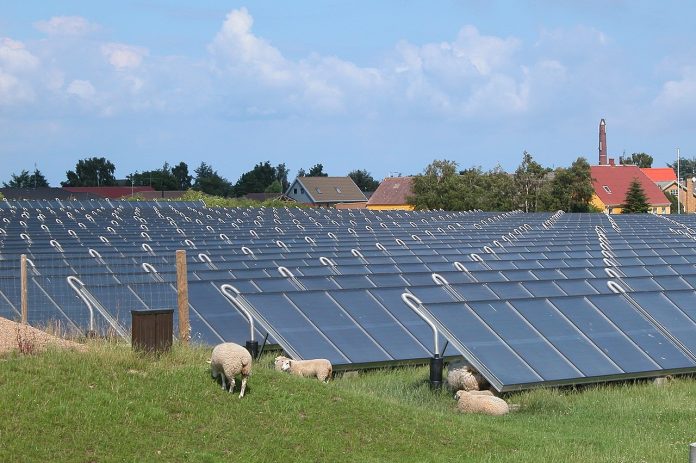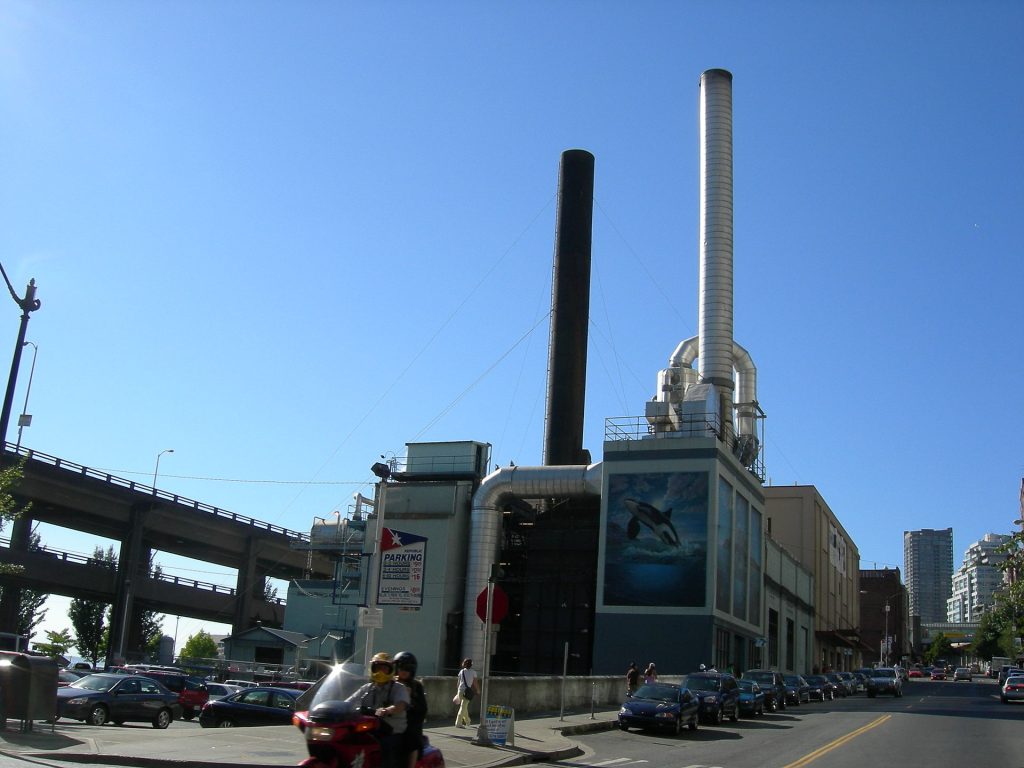In Seattle’s latest update to its energy code, bans were levied on fossil fuel and electric resistance heating systems in commercial buildings and three-plus-story multifamily residences. One exception to that ban was for district heating systems that can and do burn carbon fuels in Seattle. District heating is a subset of district energy, which according to the United States Energy Information Administration involves systems that have a central plant or plants that produce steam, hot water, or chilled water that is then pumped through a network of insulated pipes to provide space heating, cooling, or hot water for nearby buildings. More than 660 district exist in the United States.
One of these systems is operated by Enwave Seattle (formerly Seattle Steam Company), which has been has been heating buildings in the downtown area and First Hill since the 1890s with piped steam that is generated from centralized boilers. The district heating company has used coal, oil, biomass, natural gas, and electricity to power its boilers. Today, the company burns natural gas to provide heat and hot water to around 200 buildings. Another similar system exists at the University of Washington that operates a central power plant of five natural gas boilers that supply steam heat, chilled water air condition, compressed air, and emergency power to all the buildings on the main campus and medical center.
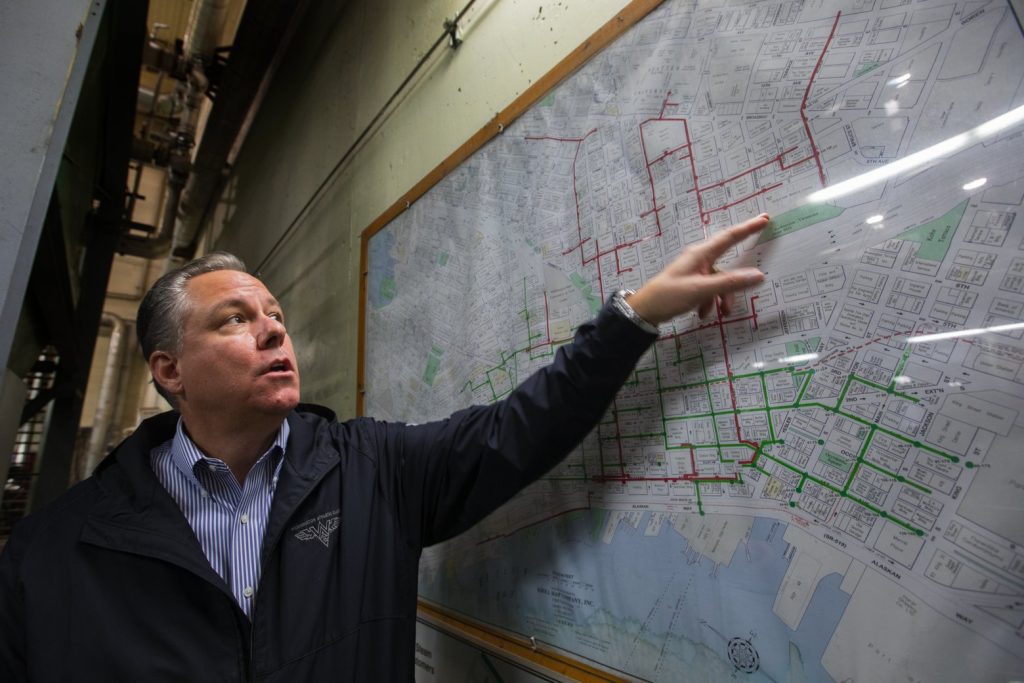
While many district energy systems currently burn fossil fuels, they do operate with high energy efficiency at economies of scale. Most of this advantage manifests in being able to aggregate the varied heating and cooling loads of multiple nearby buildings into a more steady and predictable combined load, which is generally more efficient than an inefficient need to ramp up and down heating and cooling systems of individual buildings. The distribution system of a district energy system also has the effect of energy storage, which smooths out energy generation of the central plant and allows the central plant to operate at high load factors. This operation results in higher levels of efficiency by reducing the need for excess peak heating or cooling capacity. The large scales also allows for cost efficient operation of high efficiency technologies and equipment like condensing economizers that wouldn’t be feasible for the smaller heating systems of individual buildings.
Why district energy matters
In the United States, spatial heating, air conditioning, and water heating consist of the vast majority of our residential energy consumption. According to the 2015 Residential Energy Consumption Survey, just shy of two thirds of American single-family residential energy use is consumed by space and water heating. Including air conditioning takes that fraction up to three quarters. Apartments brings that fraction down to up to two thirds for all three needs. Residential temperature regulation is also a major contributor to American greenhouse gas emissions, as the combination of natural gas, propane, and fuel oil/kerosene dominate U.S. household end-use energy consumption.
While many existing district energy systems also use fossil fuels, they are immensely flexible with the kind of fuel used to power their equipment. At home, the Seattle Steam Company–now Enwave Seattle–was converting its then oil-fired boiler to electricity-powered boilers in the 1970s. At one point, it was one of Seattle City Light’s four largest costumers, but Seattle Steam converted its boilers to natural gas in 1977 after Seattle City Light faced an energy shortage. Close by, Amazon’s headquarters relies on a district energy system powered by waste heat from a nearby data center.
Not only can district energy systems be electrified to take advantage of a non-carbon power grid, but it can use heat and energy generated by power generating and industrial processes–like you see with Amazon’s data center waste energy system–that typically goes uncaptured. Cogeneration of heat and power from nuclear, solar, and geothermal energy can be and is used for district energy systems. These systems have also been utilized by countries with high deployment of variable renewables, wind and solar, to convert excess energy–that could threaten grid stability–into heat for later use to reduce need for curtailment.
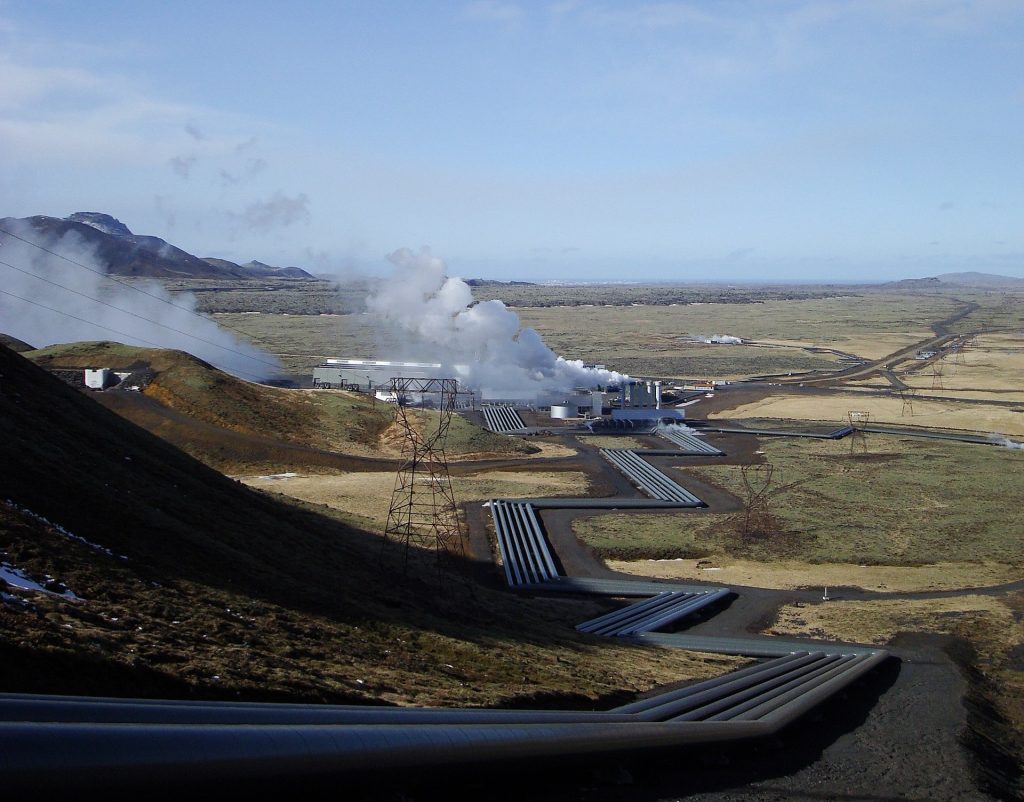
“For building developers and owners, district energy reduces the capital cost of developing an office building by cutting the boiler and chiller plant cost from the project, frees up valuable space within the building for productive service, and increases overall architectural design flexibility. … Building tenants can experience enhanced comfort and convenience through lower noise and vibration levels, and better space utilization
Energy Efficiency and Energy Security Benefits of District Energy report to Congress in July 2019 by the Department of Energy
Energy security is also strengthened by district energy systems as they can provide a redundant system to the power grid if the necessary grid infrastructure is implemented. If a district energy system is connected to a microgrid, it could provide power to critical infrastructure, heat, and cooling in case the power grid were to be disabled. Energy security is also enhanced by the storage capacity of heat within a district energy system, which could be accessed during emergencies. A system like this is installed in the Hudson Yards project in New York City, and would be useful in disaster scenarios like the recent Texas power outages caused by a freak winter freeze.
Challenges
A confluence of issues make developing district energy systems difficult. According to Department of Energy report on the benefits of district energy, challenges to developing district energy are economic, technical, and educational in nature and all weave into an interdisciplinary mess to sort out. Solid technical planning, engineering, sustainable business models, noninhibiting regulation, and good governance all need to work together to pursue and implement significant and successful district heating systems.
Breaking it down into individual fields, education plays a major issue in developing district energy systems. Many lack awareness of the system’s existence. This problem applies to building owners, facility managers, municipal planning departments, and policymakers and legislators–constituents included. In Washington state, legislative awareness does exist. The scope is limited, but new critical government facilities in the state are all required to consideration Combined Heat and Power (CHP) systems that often involves district energy. Even if awareness does exist, the expertise and resources to explore developing district energy system to act on any political will may not existing and lead to many missed opportunities.
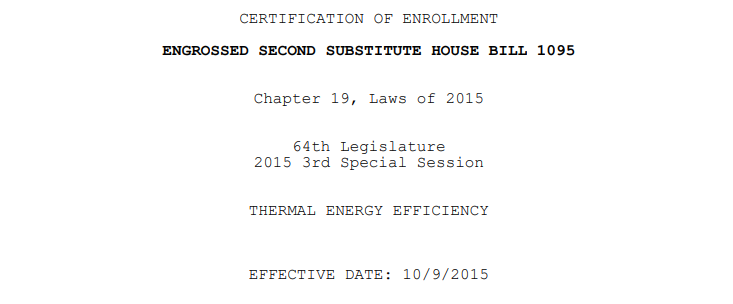
Economics of district energy also makes it challenging. Higher initial costs and perceived risk may make facilities ignore district energy and opt for small and less efficient individual systems to meet energy needs. Projects may lack early-stage funding, and may face investment limitations due to projected rates of return, risk, and competing opportunities. Economics of district energy are also challenged by relatively low energy costs that give increased energy efficiency in the sector less weight. Occasionally there are regulatory restrictions that would prevent a potential district energy system from selling products like electricity, limiting feasibility of a district energy system. These factors also make it challenging for cities and town to fund a public system, though low-cost loans and bonds have been used to develop public heating and cooling networks in municipalities.
Lastly, the Department of Energy outlines technical challenges to district energy systems. As we’ve discussed in The Urbanist, our power grid is changing and in need of change. Potential changes like wide electrification and improved electric competitors may weaken competitive advantage for thermal energy systems like district energy if appropriate levels of energy density demand isn’t met. For example, increasingly efficient heat pumps are cutting into the economic completive advantage that a district energy system could provide for markets like single family home heating. Additionally, retrofitting piping is complicated by existing infrastructure that has to be disrupted to access, repair, or expand a district energy system. The Department of Energy has identified a need to modernize district energy controls to optimize the system and integrate the system and thermal storage into the wider power grid.
Opportunity for Cities and Seattle
Cities are the best opportunity for district energy systems to thrive, the two in fact work in a rather symbiotic relationship. For a system that benefits from proximity for reduced energy loss, urban areas provide a dense base of consumers. If we consider factors like the heat island effect and local industry, cities can provide otherwise wasted heat to fuel a district energy system. Energy storage capacity in a system can also provide cities a balancing mechanism for wide but variable renewable energy adoption.
For Seattle, district energy isn’t new, just hidden from sight. Outside of the University of Washington, none of the existing systems are run by a public body. The City of Seattle and relevant regional agencies should explore district energy solutions for regional climate investments. Identifying opportunities to deploy more district energy here may be challenging, as Seattle and the greater region are dominated by low density residences, lacks geothermal resources, may not be ideal for a solar thermal plant, and may not be receptive to a nuclear plant to provide thermal energy.
Nevertheless, Seattle should have opportunities to deploy electric boilers or harness waste heat for more regional district energy. We have a wealth of technical expertise and experience from the University of Washington, Enwave Seattle, and Amazon/Clise Properties to draw from. There are also land use opportunities wherein piping will be less costly and disruptive than more developed areas.

Perhaps Interbay could be an opportunity to demonstrate a city-run district energy system that takes advantage of potential industrial waste heat, and provide dense development with a central and efficient heating, cooling, and/or power source before it gets too disruptive to install steam piping. If Seattle was able to repurpose some of its golf courses, they could also offer some of the undeveloped scale for an effective district energy system. Going off of Amazon’s model, the City of Seattle should help identify significant waste heat resources, private actors, and incentives to harness the otherwise rejected energy. More disruptive and costly would be developing these systems in urban villages and any other dense spaces, but we should consider any opportunity to to increase energy efficiency of our residences’ primary uses of energy.
District energy is an opportunity for Seattle to deploy energy storage, cooling capacity, and a more efficient and non-fossil heating method, helping the city implement climate mitigation strategies. It can also contribute to housing solutions by freeing up square footage previously taken up by bulkier temperature regulation systems for housing and other productive amenities. All the technology needs to proliferate in Seattle is political will.
Shaun Kuo is a junior editor at The Urbanist and a recent graduate from the UW Tacoma Master of Arts in Community Planning. He is a urban planner at the Puget Sound Regional Council and a Seattle native that has lived in Wallingford, Northgate, and Lake Forest Park. He enjoys exploring the city by bus and foot.

